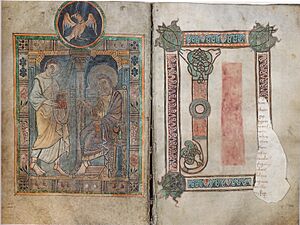Livinus facts for kids
Quick facts for kids Saint Livinius |
|
|---|---|
| Born | c. 580 Ireland |
| Died | 12 November 657 Sint-Lievens-Esse, Flanders |
| Venerated in | Eastern Orthodox Church Roman Catholic Church |
| Feast | 12 November |
Saint Livinus (born around 580 – died November 12, 657) is also known as Livinus of Ghent. He was an important religious figure in parts of what are now Belgium and the Netherlands. Many people remember him as a saint and a martyr. A martyr is someone who dies for their beliefs. His special day is November 12.
The Story of Saint Livinus
People tell a story about Livinus that says he was born into a noble family in Ireland. He traveled to Anglo-Saxon England to study, where he met Saint Augustine of Canterbury. After his studies, he went back to Ireland.
Later, Livinus left Ireland to travel and share his religious beliefs. He went to Ghent in Belgium and Zeeland in the Netherlands. He preached to many people there.
Livinus's Death
During one of his sermons, Livinus was attacked. This happened in a village called Esse, near Geraardsbergen. A group of people who did not share his beliefs hurt him badly. They cut off his tongue and his head.
Some villages were named after him because of his story. These include Sint-Lievens-Esse, where he was said to have been killed. Also, Sint-Lievens-Houtem, where he was buried, carries his name. Another place named after him is Merck-Saint-Liévin in northern France.
His remains, or what was left of his body, were moved to Ghent around the year 1000. However, they later disappeared. Many believe they were destroyed in 1578 during a time of religious conflict.
Was Saint Livinus Real?
Some recent studies have questioned if Saint Livinus truly existed. There are many similarities between his story and that of another saint, Saint Lebuinus. Saint Lebuinus was an English missionary who died around 775 in Deventer, Netherlands. He is also remembered on November 12.
Both Livinus and Lebuinus worked to spread Christianity in the Low Countries. They both faced similar problems and conflicts. Some historians think that monks in Ghent might have created the story of Saint Livinus. They may have used the life of Saint Lebuinus as their inspiration.


